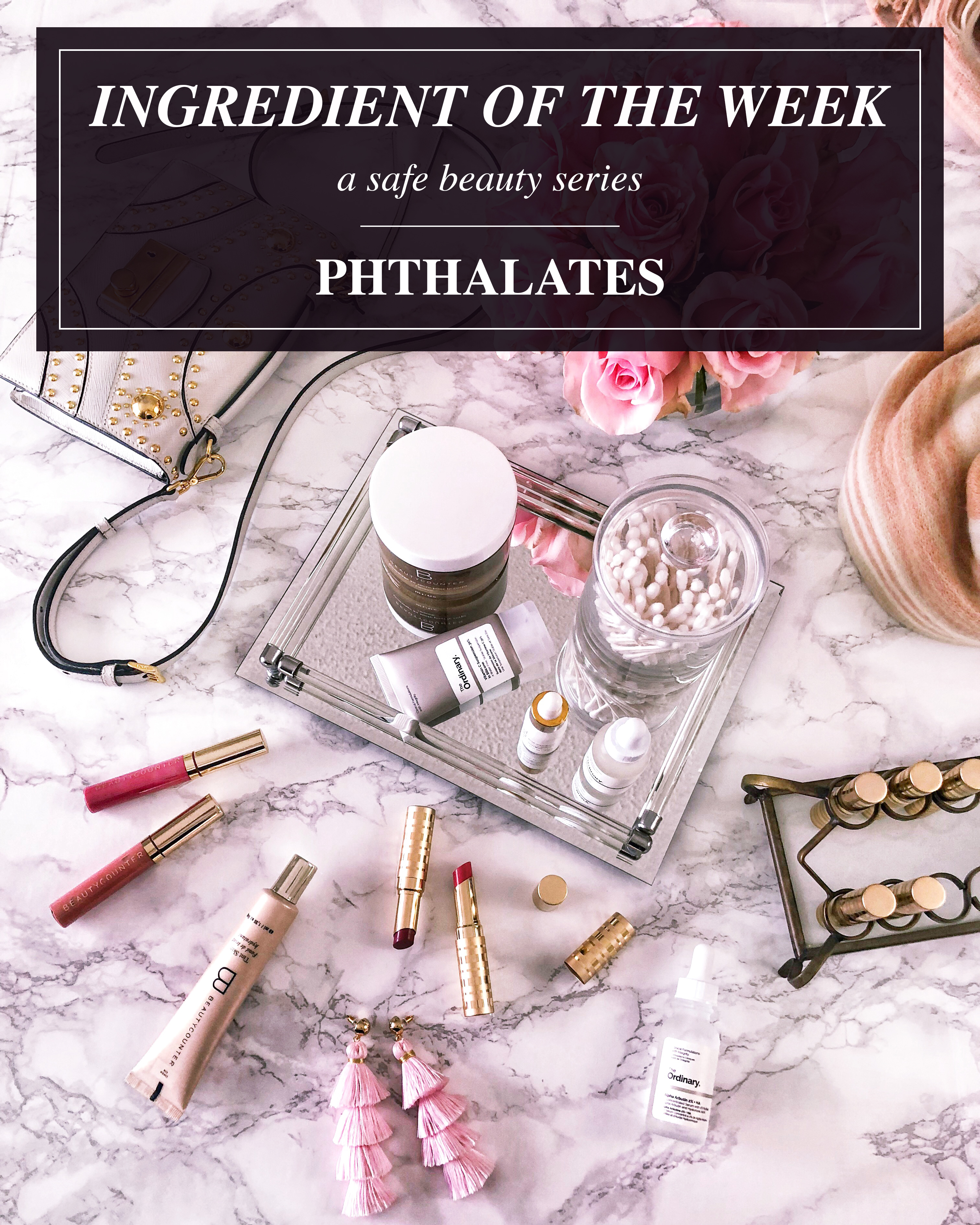
This is the third post in my new Ingredient of the Week series and I’m talking about phthalates! Luckily, they aren’t found in too many products anymore because the concerns about high toxicity are pretty widespread. Brands have worked hard to remove them, sometimes replacing them with a chemical equally harmful but not as well known. If you use plastic containers, hairspray, nail polish, or perfume, you will want to keep reading though. If you are health focused and love beauty products, make sure to keep following along with this series to find out what’s in your products!
If you missed the intro to this series, it explains what “safe beauty” is, and why it’s important. The quick version is that the FDA doesn’t regulate what chemicals brands put in their products and it doesn’t set standards for words like “natural” or “organic”. Basically, a brand could put “natural” on a container full of carcinogens if they wanted (and they often do). So let’s dive into phthalates (pronounced THAIL-ates).
WHAT ARE PHTHALATES?
What to look for.
Phthalates are still relatively easy to spot like parabens or sulfates. They aren’t always listed with the word “phthalate” at the end because long words take up real estate on labels. So, they are usually acronyms ending in the letter P.
Dimethyl Phthalate (DMP)
Dibutyl Phthalate (DBP)
Di(2-ethylhexyl) Phthalate (DEHP) – commonly found in food
Diethyl Phthalate DEP
There’s a complete list here – most appear to start with a D and end with a P. That should be easy enough to scan for on your labels!
What are phthalates?
Phthalates are chemicals that help beauty products stick to skin: a quality we all want. We don’t want our makeup to wear off instantly, right? That defeats the purpose. They’re plasticizers which increase the flexibility, durability, transparency, and longevity of the product. Kind of reminds you of plastic, right? They can also help a product better penetrate the skin, like lotion. Remember the BPA scare years ago? BPA is linked to phthalates.
Why do brands use them?
When a brand is manufacturing a product, flexibility, durability, and longevity are all things that sound pretty great. You don’t want your lipstick being so brittle, that it cracks. You won’t want it being so soft that it turns to mush. And you don’t want it losing its shape after a few weeks. Basically, phthalates help companies form products in ways that make them easy for consumers to use and meet our expectations. However, as I mentioned, brands have been cracking down on them for years and have found non-phthalate alternatives which is great news!
What products usually contain phthalates?
If you’ve ever had a foundation, a mascara, or a lipstick that lasts all day, check the label for phthalates. For example, OPI nail polishes used to contain DBP before they reformulated in 2006. They don’t currently list their ingredients on their website which is a little bit of a red flag for me. Ever wondered why your nails are so busted after gel or acrylics? This might be why. I’ve also seen them pop up in hairspray and dry shampoos (especially ones that are spray). Other than these categories, I haven’t seen a lot of them on labels.
While this isn’t a beauty product, phthalates are commonly used in plastic containers too. Check the bottom of the bottle for the little triangle symbol. If there is a 1 or 7 inside the triangle, stop using it. Numbers 2, 4, and 5 are less likely to contain BPA and phthalates. Tupperware is the first thing that comes to mind which is why we switched to glass a few years ago. It’s a bit heavier and clunkier but safer! I also found a study that said phthalates were found in some boxed macaroni and cheeses.
What they do to you.
While all three of the below are a form of endocrine disruption, I wanted to break them out because oftentimes, the words “endocrine disruption” don’t mean anything to people. I don’t know about you but I do not remember anything I learned in biology class at this point!
Endocrine disruption. As I mentioned last week, your endocrine system controls hormone production. It’s a critical system to your body and most toxic chemicals affect your hormones. This can cause developmental, reproductive, and neurological harm. Reproductive organs, especially in males, are often impacted. Think lower sperm count and activity, particularly in developing or younger humans. Men seem to be more susceptible to phthalates and a study shows that phthalates are linked to obesity and diabetes for males. Here’s another study that was done.
Birth defects. Another form of endocrine disruption, phthalates have been shown to be related to various physical deformations in animals as well as baby boys. If something is affecting your reproductive organs, it can also affect what you are reproducing.
Thyroid disruption. Specifically, DEHP has been linked to thyroid disruption.
Some safe alternatives.
If you’re not following me on Instagram, I often share my favorite non-toxic products on Stories so that is a great place to start for random, everyday products. For nail polish, Zoya is a safer brand as it was the first to remove DBP and formaldehyde. Glass tupperware can be found almost everywhere now post the BPA scare so check department stores or even Bed Bath and Beyond. I’m still on the hunt for a good hairspray or spray dry shampoo so comment below if you have one!
Have you found phthalates in your products? Do you have any favorite non-toxic dry shampoos, hairsprays, or nail polishes? Please share!
Nice post